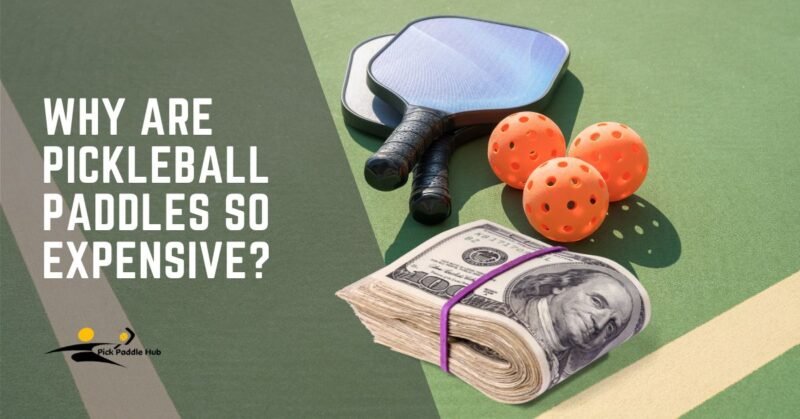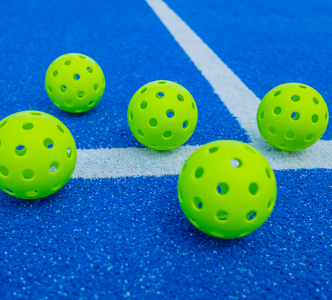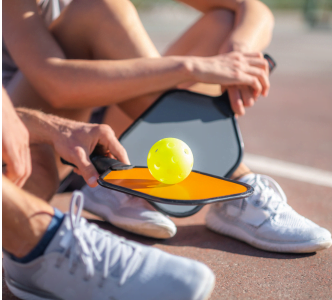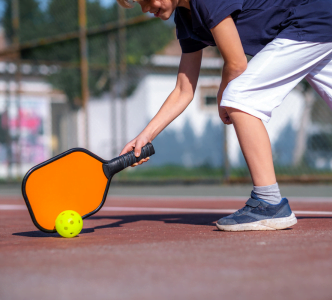As an experienced pickleball player, today I will address a topic that many pickleball players ask: Why are pickleball paddles so expensive?
When I started playing pickleball, I used a wooden pickleball paddle that cost me just $10, because this was the cheapest option at the time, and I’m sure many of you know that the cost of these pickleball paddles is not a big deal for beginners.
At first, we didn’t think about the quality of a paddle. All we wanted was to play and learn pickleball.
But as you grow and learn to play pickleball, you realize that not all pickleball paddles are the same in terms of quality and expansiveness.
Some have more power, others have better control, and some are better at absorbing vibration. Some pickleball paddles are more expensive than others.
So, why do these features of paddles come with a higher cost? Well, there are 7 reasons behind the high cost of these paddles, but the three main reasons are:
- Materials
- Shape and design
- Fancy features like edge guards and vibration-dampening
Let’s break down each one in detail.
6 Reasons Behind The Expensiveness of Pickleball Paddles
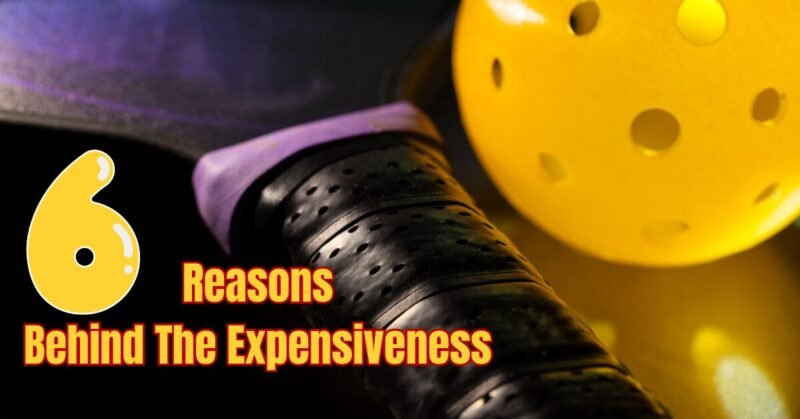
In just 50 years, pickleball has gone from a backyard game to a hugely popular competitive sport with millions of players. The paddle’s quality and materials will evolve as the pickleball sport grows.
There are differences between pickleball paddles that’s why every new pickleball player thinks that pickleball paddles are very high cost.
Here are six key reasons why pickleball paddles tend to be more expensive than other paddle sports equipment:
- Materials
- Design and shape
- Fancy features like edge guards and vibration-dampening
- Research and manufacturing process
- Brand and endorsements
- Market demand
The expense of pickleball paddles is significant due to these 6 reasons, which we have gathered through experience and research and sharing with you here. After this, we will explain further questions that will help you to know about these high-cost pickleball paddles.
Materials
The materials used in the construction of pickleball paddles, such as wood, composite, graphite, aluminum, and carbon fiber, play a crucial role in determining both the performance characteristics and the expense associated with these paddles.
Wood paddles, often the least expensive option, offer beginners a cost-effective entry point into the sport but lack the durability and performance features of more advanced materials.
Composite paddles, made from a blend of materials like fiberglass or carbon fibers, strike a balance between cost and performance, offering a versatile choice for players of varying skill levels.
Graphite paddles, known for their lightweight and stiff properties, provide excellent control and power, contributing to their higher price point.
Aluminum cores, found in some composite paddles, add strength and durability without significantly increasing the weight, making these paddles a mid-range option in terms of expense.
Carbon fiber stands out for its exceptional strength-to-weight ratio, offering top-tier performance that comes with a higher cost.
In the past, the cost of pickleball paddles was not much higher because manufacturers
used traditional materials like wood. Nowadays, you can buy wooden pickleball paddles for mostly $10 to $40. However, when it comes to advanced materials used in pickleball paddles, things start to get more expensive.
The choice of material directly impacts the pickleball paddles expense, with advanced materials like carbon fiber and graphite typically commanding higher prices due to their superior performance and durability.
Design and Shape
The design and shape of a pickleball paddle are really important because they affect how well the paddle works during a game. For example, the shape of the paddle can change how balanced it feels, how big the sweet spot is (the part of the paddle that hits the ball best), and how it feels when you play.
Some paddles are made to give you more power, while others might help you control the ball better or put a spin on it. Designing a paddle is a complicated job. It needs a lot of knowledge about materials, how air moves around objects, and what players need,
The look of the paddle also matters a lot. In the world of pickleball gear, if something looks good, it’s more likely to sell. This is why companies work hard to make paddles that not only perform well but also look great. A paddle with a cool design or bright colors can stand out and make people want to buy it, sometimes even at a higher price.
Making a paddle that looks good and works well takes a lot of effort from skilled designers and a lot of testing. This is why some paddles are more expensive, especially if they have a special design or new technology that no one else has.
If you can’t afford high-cost pickleball paddles, then you can customize your paddle by adding texture to your paddle to make the design as you want.
Fancy Features
Fancy features like edge guards and vibration dampening are more than just nice-to-have additions to pickleball paddles; they play a significant role in both the durability of the paddle and the comfort of the player during the game.
Edge guards are designed to protect the paddle’s edges from wear and tear, especially during intense play or accidental drops. This protection helps extend the life of the paddle, ensuring that players can enjoy their investment for longer periods.
On the other hand, vibration dampening is all about improving the playing experience. This feature reduces the vibration that travels through the paddle and into the player’s arm upon hitting the ball. It’s particularly beneficial for players who play frequently or those susceptible to arm fatigue or pain, as it helps minimize discomfort and the risk of injury.
These advanced features contribute to the overall cost of the paddle. Incorporating edge guards and vibration-dampening technology requires additional materials and a more complex manufacturing process, which in turn raises the price.
However, the benefits they offer in terms of durability and comfort can make them worth the extra expense for many players. By choosing a paddle with these features, players are investing in a tool that not only performs better but also promotes a healthier, more enjoyable game experience.
Research and Manufacturing Process
The research and manufacturing process behind pickleball paddles significantly contributes to their cost. Before a paddle ever hits the market, extensive research goes into its design, materials, and technology to ensure it meets the needs of players.
This research phase can involve testing different materials for durability and performance, studying aerodynamics to enhance the paddle’s speed and control, and even ergonomic studies to make sure the paddle feels comfortable in a player’s hand.
The goal is to create a paddle that not only performs well but also stands out in a competitive market. This process requires time, expertise, and often, a considerable financial investment, all of which are reflected in the final price of the paddle.
Brand and Endorsements
The brand reputation and endorsements from professional players significantly influence the price of pickleball paddles. Well-known brands that have established trust and a track record of quality in the pickleball community can command higher prices for their paddles.
When these brands are endorsed by professional players, the perceived value of their paddles increases even further. Endorsements serve as a seal of approval, suggesting that the paddles meet the high standards required for competitive play.
Consumers often are willing to pay a premium for paddles associated with top players and reputable brands, believing in the superior performance and durability these endorsements imply.
This relationship between brand prestige, professional endorsements, and consumer trust plays a crucial role in setting the price point for high-end pickleball equipment.
Market Demand
Pickleball paddles Expense is also significantly influenced by market demand. As pickleball continues to grow in popularity, the demand for equipment, especially paddles, has surged.
This increasing interest drives up the value of paddles, particularly those that offer advanced features or come from well-regarded brands. Manufacturers and retailers adjust their pricing strategies based on this demand, often resulting in higher prices for consumers.
Additionally, seasonal peaks in playing activity can further exacerbate demand, leading to price fluctuations throughout the year.
Do Expensive Pickleball Paddles Mean Better Paddles?
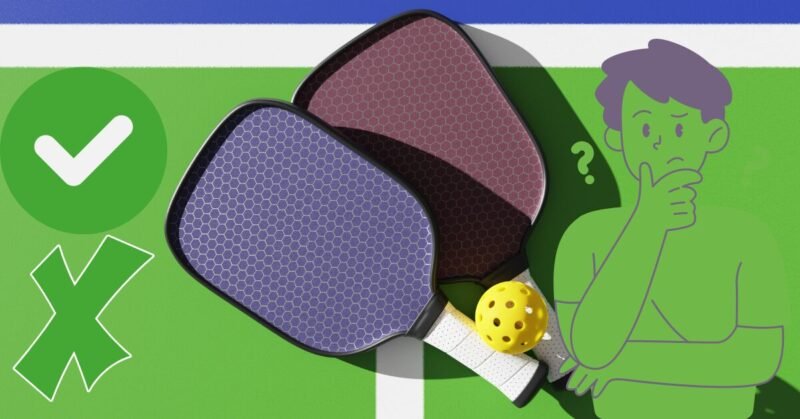
Whether expensive pickleball paddles mean better paddles depends on several factors, including the player’s skill level, playing style, and what they value in a paddle.
Generally, higher-priced paddles are made from advanced materials like carbon fiber or graphite, which offer benefits such as lighter weight, greater durability, and improved performance characteristics like power and control.
These paddles often incorporate technology designed to enhance play, such as vibration dampening and edge guards for durability.
However, a more expensive paddle doesn’t automatically make someone a better player. The right paddle for a player complements their playing style and feels comfortable in their hands.
For beginners, a basic paddle may be more appropriate and cost-effective while learning the game. As players develop their skills and understand their preferences, investing in a higher-priced paddle that meets their specific needs can be beneficial.
What is a reasonable price for a Pickleball paddle?
A reasonable price for a pickleball paddle can vary widely depending on several factors, including the materials used, the brand, and any special features the paddle may have.
Generally, prices can range from as low as $20 for basic, beginner paddles made from simpler materials like wood, to up to $200 or more for high-end models designed with advanced materials like graphite or carbon fiber and specialized technologies for improved performance.
For beginners or casual players, a paddle priced between $30 to $60 can offer a good balance of quality and affordability, providing a solid introduction to the game without a significant investment. These paddles are typically made from composite materials and may include features like a polymer core, which offers good control and durability.
Intermediate players might look towards paddles in the $60 to $120 range. Paddles in this price bracket often feature higher-quality materials and construction, such as improved composite or graphite faces, and may offer better performance characteristics like power and control, along with durability.
Advanced or competitive players who are looking for the best performance and don’t mind investing more might consider paddles priced from $120 to $200 or more. These paddles often incorporate the latest technologies, the highest quality materials, and design innovations for optimal playability, including carbon fiber faces, vibration-dampening systems, and larger sweet spots.
Conclusion
The world of pickleball paddles is diverse, with options available for players of all skill levels and budgets.
While expensive pickleball paddles offer advanced materials, superior design, and specialized features that can enhance play, it’s important to remember that the best paddle is one that matches a player’s style, needs, and level of commitment to the game.
Investing in a paddle that feels right for you and complements your playstyle is a step towards enjoying the game more and potentially improving your performance on the court.
FAQ’s
Is it worth it to buy an expensive pickleball paddle?
Buying an expensive pickleball paddle can be worth it if you play frequently and are looking to enhance your game with advanced features like improved control, power, and durability. These paddles often offer better materials and technology, which can make a noticeable difference in performance for competitive or advancing players.
How many games does a pickleball paddle last?
The lifespan of a pickleball paddle can vary widely depending on its construction, materials, and how often it’s used. On average, a well-made paddle can last from 1 to 5 years with regular play. High-quality paddles may last longer if properly cared for and used under normal conditions.
How do you know a good pickleball paddle?
A good pickleball paddle should feel comfortable in your hand, match your playing style, and meet your performance needs. Look for paddles with a grip size that fits your hand, a weight that complements your play style (lighter for control, heavier for power), and materials that offer a balance of power and control.
Is there a difference between cheap and expensive pickleball paddles?
Yes, there is a difference between cheap and expensive pickleball paddles, mainly in materials, construction, and technology. Expensive paddles often feature advanced materials like carbon fiber or graphite, which provide better performance and durability. They may also include specialized features like vibration dampening and larger sweet spots.
How many pickleball paddles should you have?
Having at least two pickleball paddles is advisable, especially for competitive players. This ensures you have a backup in case of damage or wear during a match. Additionally, having multiple paddles can allow you to adjust to different playing conditions or experiment with varying styles of play.

